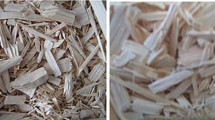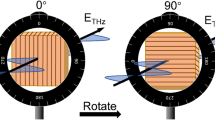Summary
Dielectric measurements at 3 GHz were made for three softwoods, European pine, spruce and hemlock. The longitudinal, radial and tangential grain directions of the wood were considered as well as moisture contents ranging from 6% to 35%. The positive effect of the moisture content on the loss factor ε″ illustrates the selectivity of microwave drying techniques, while the observations also show that the longitudinal dielectric properties are substantially higher than the transverse ones. The specific effect of the wood species on the dielectric behaviour has to be ascribed mainly to those intrinsic characteristics of the species which influence the sorptive capacity of the wood.
Similar content being viewed by others
References
Barnes, D.; Admiraal, L.; Pike, R. L.; Mathur, V. N. P. 1976: Continuous system for the drying of lumber with microwave energy. Forest Prod. J. 26 (5): 31–42
Brown, J. H.; Skaar, C. 1963: Dielectric properties of wood and wood adhesives. FAO, Fifth Conference on Wood Tech., US Forest Products Laboratory, Madison, Wisconsin, 1963 FAO/WTC/63/PP/8
Dench, E. C. 1973: Advantages of microwave processing. Trans. Intl. Microwave Power Inst. 1: 13–16
Gruber, G. 1967: Practical aspects of microwave vencer redyring. J. Microwave Power 2 (2): 51–52
Hearmon, R. F. S.; Burcham, J. N. 1954: The dielectric properties of wood. Dept. of Sci. and Industr. Res. London, For. Prod. Res. Special Report No. 8
Hippel (von), A. 1943: The measurement of dielectric constant and loss with standing waves in coaxial wave guides. Massachusetts Institute of Technology, Cambridge, Mass. National Defense Res. Comm. Report No. 142
Illingworth, P.; Klein Jr., H. 1977: Microwave drying of ponderosa pine cross-sectional disks. Forest Prod. J. 27 (2): 36–37
James, W. L. 1977: Dielectric behaviour of Douglas-fir at various combinations of temperature, frequency and moisture content. Forest Prod. J. 27 (6): 44–48
James, W. L.; Hamill, D. W. 1965: Dielectric properties of Douglas-fir measured at microwave frequencies. Forest Prod. J. 15 (2): 51–56
Kröner, K.; Pungs, L. 1952: Zur dielektrischen Anisotropie des Naturholzes im großen Frequenzbereich. Holzforschung 6 (1): 13–16
Lin, R. T. 1967: Review of the dielectric properties of wood and cellulose. Forest Prod. J. 17 (7: 61–66
McAlister, W. R.; Resch, H. 1971: Drying 1-inch ponderosa pine lumber with a combination of microwave power and hot air. Forest Prod. J. 21 (3): 26–34
Norimoto, M.; Hayashi, S.; Yamada, T. 1978: Anisotropy of dielectric constant in coniferous wood. Holzforschung 32 (5): 167–172
Rafalski, J. 1966: Über die dielektrischen Eigenschaften unterschiedlich verdichteten Rotbuchenvollholzes. Holztechnologie 7 (2): 118–122
Resch, H. 1967: Drying of incense cedar pencil slats by microwave power. J. Microwave Power 2 (2): 45–49
Resch, H. 1968: Über die Holztrocknung mit Mikrowellen. Holz Roh-Werkstoff 26 (9): 317–324
Skaar, C. 1948: The dielectric properties of wood at several radio frequencies. N.Y. State College of Forestry, Syracuse, Tech. Pub. No. 69
Tinga, W. R. 1969: Dielectric properties of Douglas fir at 2.45 GHz. J. Microwave Power 4 (3): 162–164
Tinga, W. R.; Nelson, S. O. 1973: Dielectric properties of materials for microwave processing — Tabulated. J. Microwave Power 8 (1): 23–65
Vermaas, H. F. 1974: Dielectric properties of Pinus pinaster as a function of its alcohol-benzene-soluble content. Wood Science 6 (4): 363–367
Vermaas, H. F. 1976: The dielectric constant of solid wood substance calculated with two different methods. Holzforschung 30 (3): 97–98
Vodoz, J. 1957: Das Verhalten des Holzes während der Trocknung im hochfrequenten Wechselfeld. Holz Roh-Werkstoff 15 (8): 327–340
Author information
Authors and Affiliations
Rights and permissions
About this article
Cite this article
Peyskens, E., de Pourcq, M., Stevens, M. et al. Dielectric properties of softwood species at microwave frequencies. Wood Sci. Technol. 18, 267–280 (1984). https://doi.org/10.1007/BF00353363
Received:
Issue Date:
DOI: https://doi.org/10.1007/BF00353363




